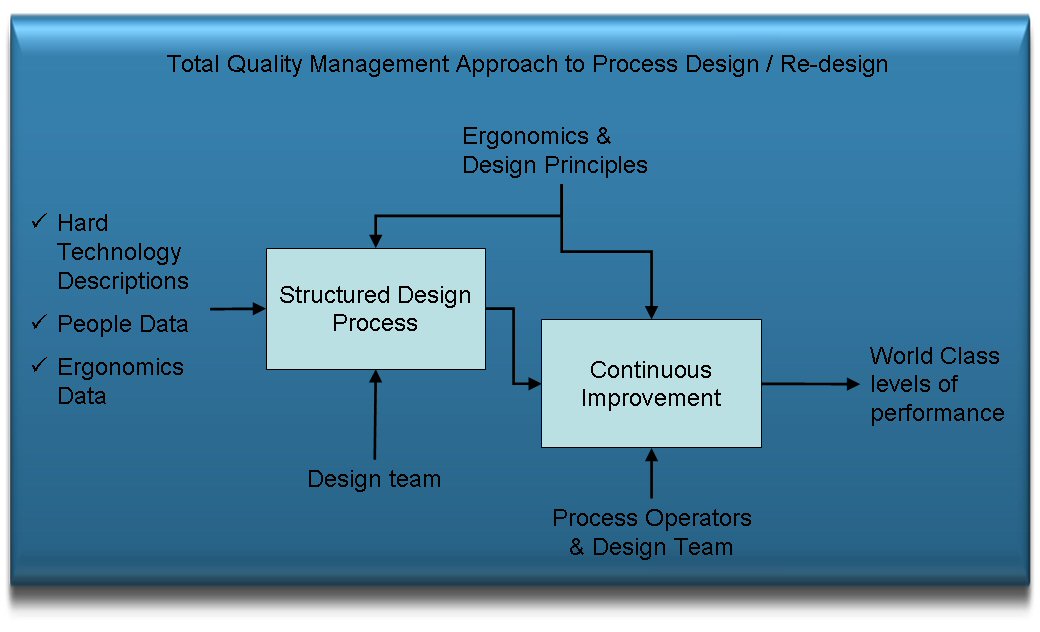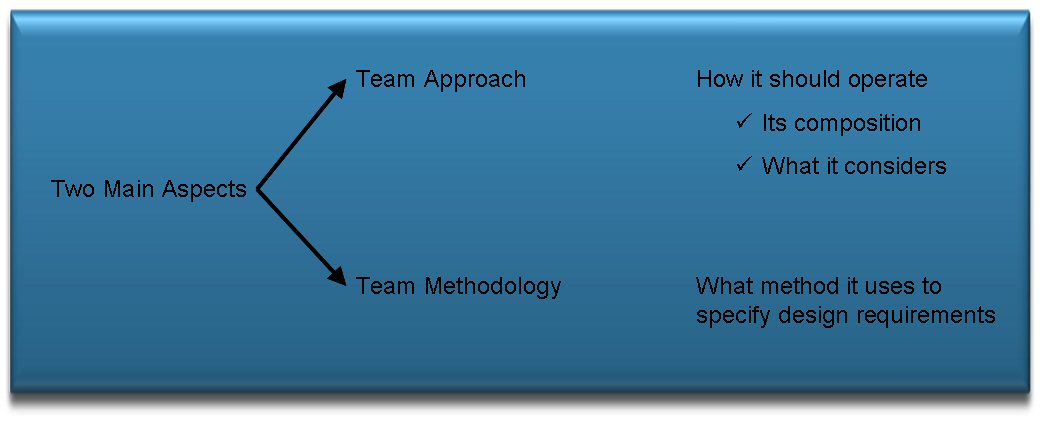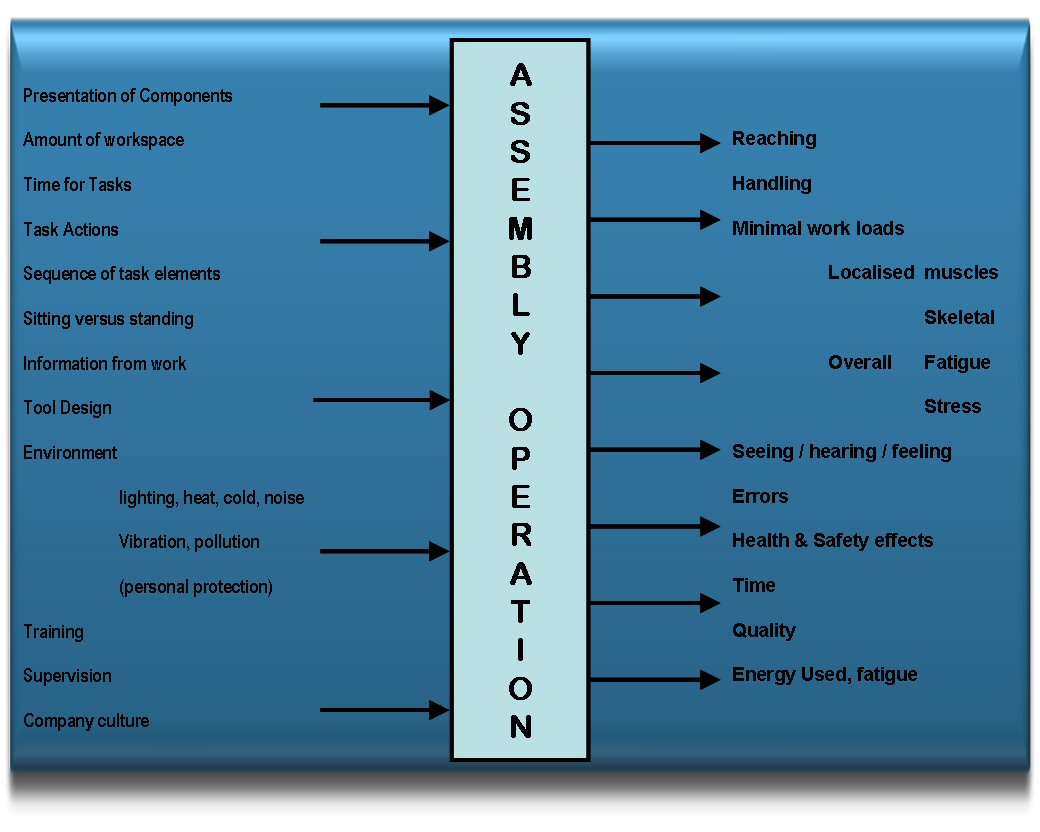4.17 - Ergonomics in TQM
Overview
In many workplaces the development of the work systems tends to concentrate on getting the machine and equipment operational with little regard for the human element required in the end result. This is seen from the design of a large piece of plant to individual workstations.
What is Ergonomics?
Ergonomics optimises the relationship between people and their activities by the systematic application of human sciences integrated in the framework of systems engineering. This maximises the effectiveness of the system which includes safety and efficiency, as well as the well-being of individuals.
It is concerned with matching the work and the work environment scientifically to human psychology and physical capability. Therefore we need data about human capability to optimise systems design.
Benefits of Ergonomics in Manufacturing Design
Factors such as poorly designed presentation of information, layout of controls and general workstation design can lead to a more difficult job, less reliable human performance, pooper health and safety - all of which can have immense impact on the effectiveness of work systems.
Taking account of human performance and improving features of the standard work cycle can improve productivity in the following ways:-
- Decrease errors and / or time taken by tasks
- Lower management and administrative burdens
- Improve efficiency by
- A smaller workforce
- Minimal work-related illness / absenteeism
- Improve profitability by better heath and safety
- Reduce short term work-related illness
- Lower workplace insurance
- Fewer substantial compensation claims
- Decrease training and associated costs
- Need fewer skilled trainers
- Simplification of activities
Design Approach
Two general design situations can be identified - new design / or re-design. The approach used in both cases can utilise similar techniques depending at what level the analysis occurs. The figure below illustrates ergonomics in relation to the input / output summary for the Management Development process.

Ergonomics needs to be highlighted in the design team / task force programme in order for Total Quality to be effective. Complimentary to this is the need to specify structured ergonomic standards and procedural methods so that suppliers are required to take account of ergonomics to improve the machines and equipment provided for the manufacturing process.
The key to cost effective design is the approach taken by the design team and the methods it uses - this applies from the Design Concept Stage during and throughout Product Design and Production Methods Development.
A common theme throughout the design process is the need to detail workers task requirements to identify and rectify problem areas and to design tasks taking account of worker capability and, psychological and physical.
Basic Principles
What is the worker required to do? |
} |
Describe in detail using flowcharts and other methods |
| How are a range of workers required to do it? |
This is applied throughout the design process - from concept to implementation.
Ergonomics Inputs into System Design

Approach and Method to be used by the design team

How the Team Should Approach Design
- Build in worker feed back
- Build in ergonomics expertise
- Describe / detail what is to be done (process and parts thereof)
- Describe / detail how it is to be done by people - including allocation of function between person and machine.
- Require detailed specification of tasks at an early stage e.g. task analysis / synthesis - task elements specified in terms of what operator is required to do - how s/he is required to do it and a separation into value added and no value added activity in the worker work cycle.
- Ensure ergonomics input to continuous improvement process
Methods Teams Should Use
- Different levels of checklist at different stages in the design of a standard work cycle.
- System and sub-system analysis
- Systems analysis techniques for example input / output analysis to include ergonomics requirements
- Detailed specification of tasks
- Task analysis / synthesis - task elements specified in terms of what operator is required to do, how a range of operators are required to do it.
- Method study techniques highlighting detailed aspects of tasks
- Multiple activity tasks
- Process charts
- Job process charts
- Design techniques / methods modified to incorporate questions about person and task, task elements, time requirements.
- Failure Modes and Effects Analysis (FMEA - see guide 5.30)
- Quality Function Deployment (QFD - see guides 6.07 & 6.08)
- Structured Analysis & Design Technique (SADT - guide 4.04)
- Controlled Requirements Expression (CORE - see guide 4.05)
- Worker Feedback Techniques
- Questionnaires
- Formal Consultation
- Evaluations of existing tasks on the same site
- Preliminary
- Detailed
- Relative energy requirements during the work cycle - distance, effort etc.
- Simulation - (synthesise task where no example available) by:-
- Computer based methods
- On-Site exercises
- Desktop exercises using:-
- Workstation physical envelopes
- Lines of sight
Input / Output Analysis of Assembly Operations Including Ergonomics
